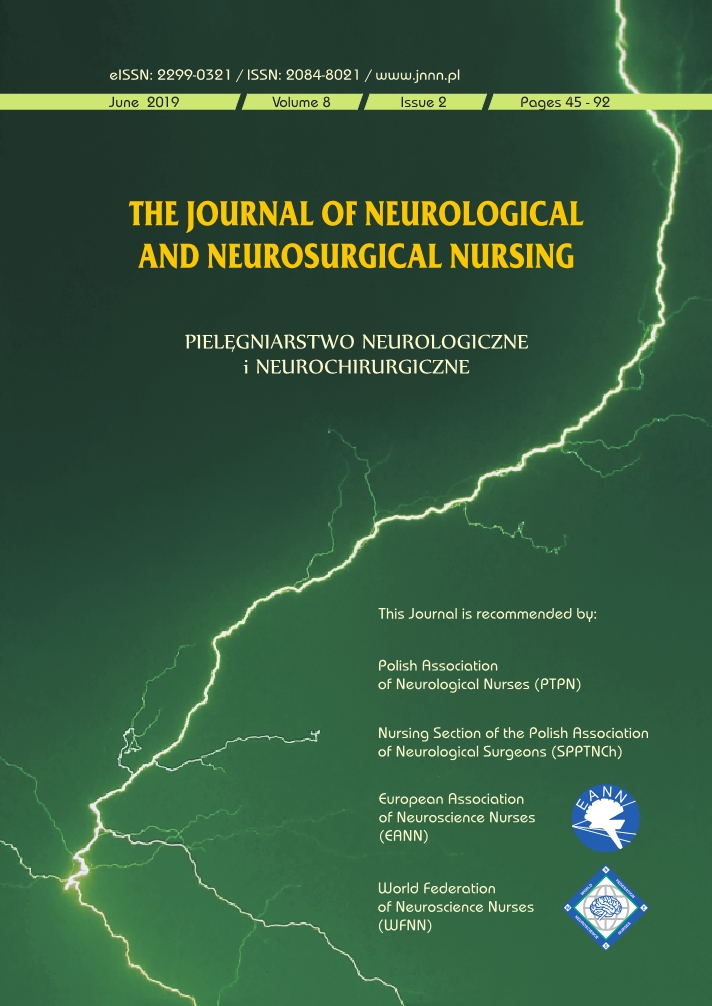Piloting Test of a Mindfulness Meditation Intervention to Reduce Stress in Younger Stroke Patients
DOI:
https://doi.org/10.15225/PNN.2019.8.2.1Keywords
stroke, nursing, meditation, complementary therapiesAbstract
Introduction. The population of younger people having strokes is growing. Persons who are younger and have a stroke have specific stressors after a stroke that those over 60 may not experience (e.g., ability to earn an income, provide for a family, returning to work, etc.).
Aim. In order to address some of these age-specific stressors, new and novel approaches to stress mediation are needed. In order to address this gap in the literature this study piloted a mindfulness meditation with younger in hospital stroke survivors.
Material and Methods. Prospective non-randomized pilot study of in-hospital stroke patients < 60 years of age. Baseline assessment included the Perceived Stress Scale (PSS), heart rate (HR), blood pressure (BP), and respiratory rate (RR). Patients received a 10-minute mindfulness training session with instructions for home use. PSS, HR, BP, and RR were collected immediately after training and telephone assessments of PSS were collected 30-day post discharge.
Results. The mean age of the 21 patients included in the final analysis was 47.4 years. Paired t-test showed statistically significant differences in heart rate (p < 0.001) and respiratory rate (p < 0.001) before and after the intervention, but no statistically significant differences in pre and post training blood pressure (p = 0.480). There was no statistically significant difference in PSS scores before and after the training.
Conclusions. The findings of this study suggest that the mindfulness intervention is feasible for in-hospital stroke patients and shows promise for reducing stress, as indicated by physiologic changes such as lowering heart and blood pressure rates. (JNNN 2019;8(2):48–53)
References
Ni C., Peng J., Wei Y. et al. Uncertainty of Acute Stroke Patients: A Cross-sectional Descriptive and Correlational Study. J Neurosci Nurs. 2018;50(4):238–243.
Kvistad C.E., Oygarden H., Logallo N. et al. A stress-related explanation to the increased blood pressure and its course following ischemic stroke. Vasc Health Risk Manag. 2016;12:435–442.
Smajlović D. Strokes in young adults: epidemiology and prevention. Vasc Health Risk Manag. 2015;11:157–164.
Creswell J.D., Lindsay E.K. How Does Mindfulness Training Affect Health? A Mindfulness Stress Buffering Account. Curr Dir Psychol Sci. 2014;23(6):401–407.
Amann C., Geipel A., Müller A. et al. Fetal anemia of unknown cause--a diagnostic challenge. Ultraschall Med. 2011;32(Suppl 2):E134–140.
Benjamin E.J., Blaha M.J., Chiuve S.E. et al. Heart Disease and Stroke Statistics-2017 Update: A Report From the American Heart Association. Circulation. 2017;135(10):e146–e603.
Dorsey M.K., Vaca K.J. The stroke patient and assessment of caregiver needs. J Vasc Nurs. 1998;16(3):62–67.
Singhal A.B., Biller J., Elkind M.S. Recognition and management of stroke in young adults and adolescents. Neurology. 2013;81(12):1089–1097.
Edwards J.D., Kapoor A., Linkewich E., Swartz R.H. Return to work after young stroke: A systematic review. Int J Stroke. 2018;13(3):243–256.
Leslie K., Sessler D.I. The implications of hypothermia for early tracheal extubation following cardiac surgery. J Cardiothorac Vasc Anesth. 1998;12(6 Suppl 2):30–34; discussion 41–44.
Ostwald S.K., Bernal M.P., Cron S.G., Godwin K.M. Stress experienced by stroke survivors and spousal caregivers during the first year after discharge from inpatient rehabilitation. Top Stroke Rehabil. 2009;16(2):93–104.
Lazarus R.S. Psychological stress and coping in adaptation and illness. Int J Psychiatry Med. 1974;5(4):321–333.
Kabat-Zinn J. Mindfulness-Based Interventions in Context: Past, Present, and Future. Clin Psychol Sci Pract. 2003;10(2):144–156.
Bishop S.R., Lau M., Shapiro S. et al. Mindfulness: A Proposed Operational Definition. Clin Psychol Sci Pract. 2004;11(3):230–241.
Lawrence M., Booth J., Mercer S., Crawford E. A systematic review of the benefits of mindfulness-based interventions following transient ischemic attack and stroke. Int J Stroke. 2013;8(6):465–474.
Laures-Gore J., Marshall R.S. Mindfulness meditation in aphasia: A case report. NeuroRehabilitation. 2016;38(4):321–329.
Creswell J.D. Mindfulness Interventions. Annu Rev Psychol. 2017;68:491–516.
Kabat-Zinn J. An outpatient program in behavioral medicine for chronic pain patients based on the practice of mindfulness meditation: theoretical considerations and preliminary results. Gen Hosp Psychiatry. 1982;4(1):33–47.
Johnson S., Gur R.M., David Z., Currier E. One-Session Mindfulness Meditation: A Randomized Controlled Study of Effects on Cognition and Mood. Mindfulness. 2015;6(1):88–98.
Kabat-Zinn J., Lipworth L., Burney R. The clinical use of mindfulness meditation for the self-regulation of chronic pain. J Behav Med. 1985;8(2):163–190.
Olson D.M., Juengst S.B. The hospital to home transition following acute stroke. Nurs Clin North Am. (Epub 8 June 2019). doi: org/10.1016/j.cnur.2019.04.007
Polit D.F., Beck C.T. Nursing Research: Generating and Assessing Evidence for Nursing Practice. 8th Edition. Wolters Kluwer Health/Lippincott Williams & Wilkins, Philadelphia 2008.
Downloads
Published
How to Cite
Issue
Section
License

This work is licensed under a Creative Commons Attribution-NoDerivatives 4.0 International License.
Stats
Number of views and downloads: 402
Number of citations: 0
